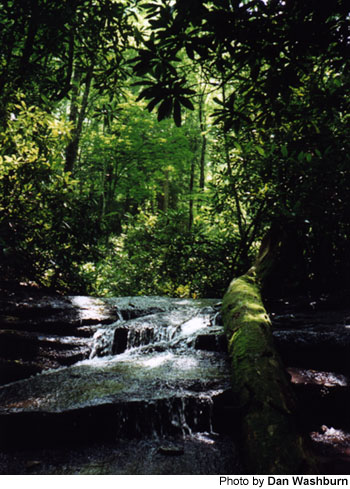
August 22, 2000 — The food just kept on coming.
Biscuits and cornbread. Fried chicken and country ham. Fried okra and corn on the cob. Plenty of sweet tea to wash it all down.
For the hungry hiker, the Dillard House rules. Although anything other than beef jerky, trail mix and iodine-treated creek water likely would have tasted fine to me.
My brother and I had just emerged from 24 hours of solitude along the James E. Edmonds Backcountry Trail in Black Rock Mountain State Park, about a 1.5-hour drive north of Gainesville in Mountain City.
Our stomachs felt neglected. Our bodies did not.
At 3,640 feet, Black Rock Mountain is the highest state park in Georgia. It is surrounded by the Blue Ridge Mountains, and straddles the Eastern Continental Divide.
Edmonds Trail is a 7.2-mile loop that meanders the lush hardwood forests of Black Rock Mountain’s lower slopes. Sometimes moderately — often strenuously — the trail rises and falls with the several knobs, mountains and ridges that cross its path.
We hiked the trail in July, in the dead of the dreaded Georgia drought, but oddly there were times we felt as though we were trudging through a rainforest.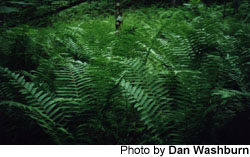
Plant life was abundant and, seemingly, flourishing. Ferns, bright green and bountiful, blanketed the forest floor. Creeks named Taylor and Greasy flowed freely in and out of Black Rock Lake. The occasional waterfall cascaded down a mossy slant of stone.
Humidity followed us everywhere, making already hot temperatures feel even hotter. The humidity was so palpable, in fact, that it took on a life of its own.
Humidity became the third member of our hiking party.
We sweated through areas of dense coverage, where hardwoods and rhododendrons occluded the sky above. It wasn’t until we passed over a gravel road — a feature that somewhat tempers the trail’s primitive feel — that we could look up and see the dark clouds that had moved in.
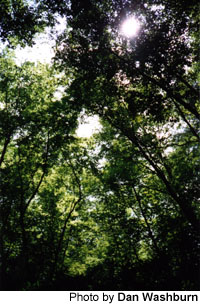 Rain began to fall as we marched on. The forest’s thick canopy, however, impeded the water’s progress far above us. But the random drop that did make its way to our skin was refreshing.
Rain began to fall as we marched on. The forest’s thick canopy, however, impeded the water’s progress far above us. But the random drop that did make its way to our skin was refreshing.
We hiked 3.7 miles counterclockwise around the loop to the primitive campsite at Lookoff Mountain, one of four campsites available by reservation along the trail.
Our camping area was a veritable luxury suite for primitive camping, a small clearing with a fire ring and three wooden benches included. We set up camp, gathered firewood and headed to the nearby Lookoff Mountain overlook. It felt good to leave our backpacks behind.
The scene was that of a pastoral painting, with the Little Tennessee River Valley fading into the green forest of Smokehouse Knob. Red-roofed barns sat beside old country churches. Cows grazed on open farmland.
Then everything grew dark. The sky filled with a gray haze. The glow from the sun fell behind the rolling hills. The picture became abstract. Distant mountains appeared one-dimensional, like black shadows of themselves. A strong breeze blew across my perch. 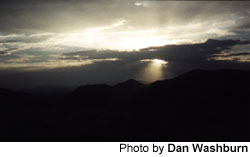
But every so often, a celestial light would break through the clouds. And a comforting patch of green would shine through the darkness.
Humidity awoke us the next morning and told us to get on our way. It also made a dip in Black Rock Lake a must. The lake is worth the short hike off the trail it takes to get there. The water was refreshing, and trash cans there allowed us to lighten the weight of our packs.
Shortly after the swim we refilled our water containers in Taylor Creek. Crystal Light lemonade powder, by the way, masks the nasty taste of iodine tablets quite well.
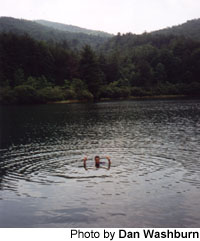 Greasy Creek added a pleasant soundtrack to the final two miles of the trail. The beauty of several creek crossings, cascades and waterfalls make this section’s steep climbs — some of the loop’s toughest — easier to endure.
Greasy Creek added a pleasant soundtrack to the final two miles of the trail. The beauty of several creek crossings, cascades and waterfalls make this section’s steep climbs — some of the loop’s toughest — easier to endure.
And so does the thought of what awaits you just down the road in Dillard — plate after plate of home-cooked southern fare.
Chicken-fried steak and peach cobbler go a long way toward soothing a backpacker’s aching body.
